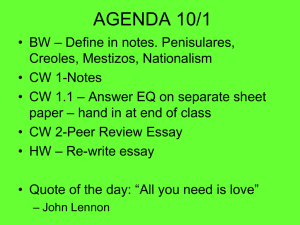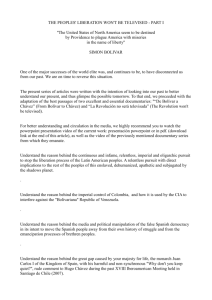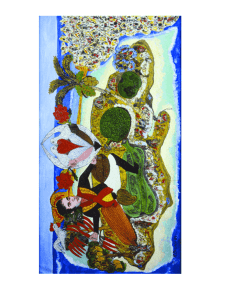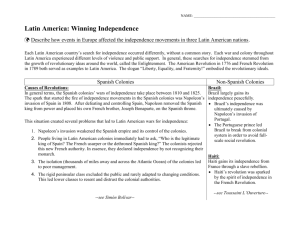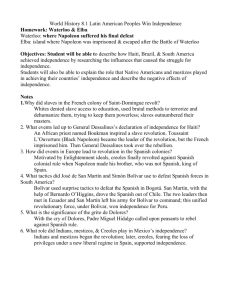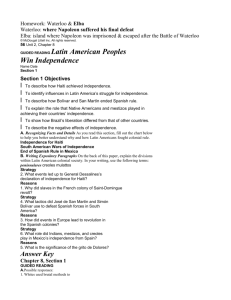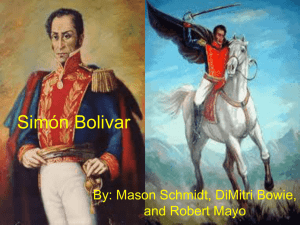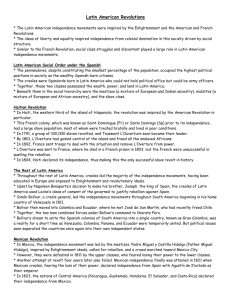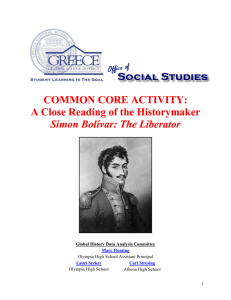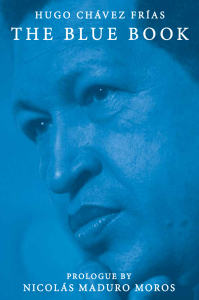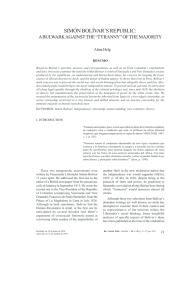Revolutions in Latin America: Bolívar, 1813–1814
advertisement
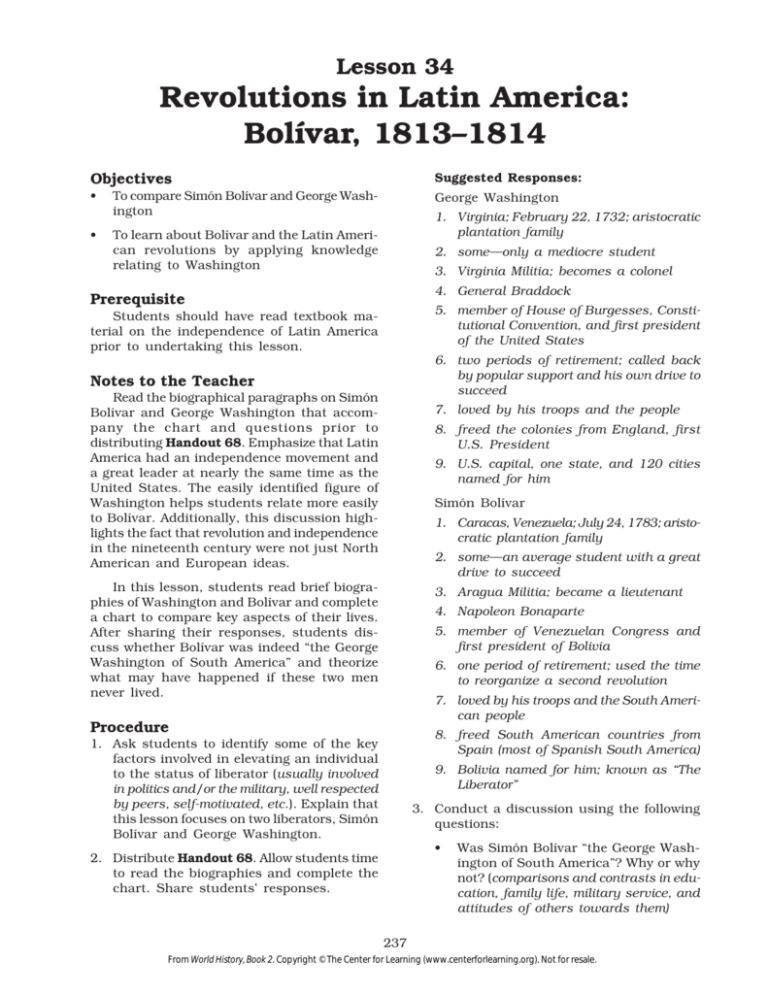
Lesson 34 Revolutions in Latin America: Bolívar, 1813–1814 Objectives Suggested Responses: • To compare Simón Bolívar and George Washington George Washington • To learn about Bolívar and the Latin American revolutions by applying knowledge relating to Washington 2. some—only a mediocre student 1. Virginia; February 22, 1732; aristocratic plantation family 3. Virginia Militia; becomes a colonel 4. General Braddock Prerequisite Students should have read textbook material on the independence of Latin America prior to undertaking this lesson. 5. member of House of Burgesses, Constitutional Convention, and first president of the United States Notes to the Teacher 6. two periods of retirement; called back by popular support and his own drive to succeed Read the biographical paragraphs on Simón Bolívar and George Washington that accompany the chart and questions prior to distributing Handout 68. Emphasize that Latin America had an independence movement and a great leader at nearly the same time as the United States. The easily identified figure of Washington helps students relate more easily to Bolívar. Additionally, this discussion highlights the fact that revolution and independence in the nineteenth century were not just North American and European ideas. 7. loved by his troops and the people 8. freed the colonies from England, first U.S. President 9. U.S. capital, one state, and 120 cities named for him Simón Bolívar 1. Caracas, Venezuela; July 24, 1783; aristocratic plantation family 2. some—an average student with a great drive to succeed In this lesson, students read brief biographies of Washington and Bolívar and complete a chart to compare key aspects of their lives. After sharing their responses, students discuss whether Bolívar was indeed “the George Washington of South America” and theorize what may have happened if these two men never lived. 3. Aragua Militia; became a lieutenant 4. Napoleon Bonaparte 5. member of Venezuelan Congress and first president of Bolivia 6. one period of retirement; used the time to reorganize a second revolution 7. loved by his troops and the South American people Procedure 8. freed South American countries from Spain (most of Spanish South America) 1. Ask students to identify some of the key factors involved in elevating an individual to the status of liberator (usually involved in politics and/or the military, well respected by peers, self-motivated, etc.). Explain that this lesson focuses on two liberators, Simón Bolívar and George Washington. 9. Bolivia named for him; known as “The Liberator” 3. Conduct a discussion using the following questions: • 2. Distribute Handout 68. Allow students time to read the biographies and complete the chart. Share students’ responses. Was Simón Bolívar “the George Washington of South America”? Why or why not? (comparisons and contrasts in education, family life, military service, and attitudes of others towards them) 237 From World History, Book 2. Copyright © The Center for Learning (www.centerforlearning.org). Not for resale. • • Do you think that Bolívar would have accomplished what he did without role models to follow? Why or why not? Give examples of these role models. (Perhaps not. Responses should reflect how Bolívar was influenced by Washington and other U.S. leaders, French Republican leaders, and Napoleon Bonaparte.) Enrichment/Extension 1. Both Washington and Bolívar have been called the father of their country. Have students draw and explain cartoons that illustrate this nickname for each leader. Display cartoons in the classroom. 2. Have students research and report on another liberator, such as Toussaint L’Ouverture, Father Miguel Hidalgo y Costilla, José Maria Morelos y Pavón, or José de San Martin. Helpful Web sites include What do you think would have happened in the United States and South America if neither of these men had lived? (the failure of independence movements and either continued colonial status or future independence revolts) • The African Diaspora: The Haitian Revolution (http://www.wsu.edu/%7Edee/ DIASPORA/HAITI.HTM) • Miguel Hidalgo (http://www.newadvent. org/cathen/16045a.htm) • Mexican Independence (http://www. tamu.edu/ccbn/dewitt/mexicanrev. htm#morelos) • General José Francisco de San Martin (http://mailer.fsu.edu/~akirk/tanks/ argentina/SanMartin.htm). Allow class time for oral reports. 238 From World History, Book 2. Copyright © The Center for Learning (www.centerforlearning.org). Not for resale. World History, Book 2 Lesson 34 Handout 68 (page 1) Name ______________________ Date _______________________ Comparative Biographies Read the following information about two liberators, George Washington and Simón Bolívar. Then compare their lives by completing the chart. Be prepared to share your responses. George Washington George Washington was born on February 22, 1732, in Virginia to an aristocratic plantation family. He was a fair student as a child and eventually learned the trade of surveying, but he longed for adventure as a young man and became a member of the Virginia Militia. Washington eventually rose to the rank of colonel and was greatly influenced by General Braddock of the British Regular Army. The campaigns in which Washington fought under General Braddock during the French and Indian War trained him well for the future. After the war, Washington retired to his Virginia estate at Mount Vernon and was elected to the Virginia House of Burgesses. When the American Revolution started in 1775, Washington was seen as the best choice to lead the American Army. His leadership through victory and defeat made him greatly loved and admired both by his troops and the people. Under his leadership, the American colonial armies defeated the British in 1781. The Treaty of Paris, signed in 1783, officially ended the Revolutionary War. Washington again retired from public service, but after the ratification of the U. S. Constitution at the Constitutional Convention, which he led, he was elected the first president of the United States. Washington has been honored for his efforts. The U. S. capital, one of the fifty states, and one hundred and twenty cities bear his name. Simón Bolívar Simón Bolívar was born in Caracas, Venezuela, on July 24, 1783, to aristocratic parents who were wealthy plantation owners. He was a good student as a child and teen but longed for more adventure. In his late teens, he joined the Aragua Militia, a local defense force, and rose to the rank of lieutenant. He then traveled to Spain for further education and was heavily influenced by revolutionary/republican ideas, especially those of Napoleon Bonaparte in France. He returned home to South America determined to win its freedom from Spain. Bolívar, under the leadership of a man named Miranda, fought in the first revolt against Spain in 1811. This revolt failed, and Miranda was captured. Bolívar then went home, but under pressure from people in the independence movement and his own strong beliefs, he began to organize a second revolution. During this time, he was elected to the Venezuelan Congress as a representative and was a driving force behind the writing of the Venezuelan Constitution. In late 1812 and early 1813, Bolívar began a series of attacks that eventually freed Venezuela and most of South America from Spanish domination. Because of his leadership, he was seen as a father figure by his soldiers and was greatly loved by many South Americans. The country of Bolivia is named for him, and he is often referred to as “the George Washington of South America.” He was elected the president of the new country of Bolivia and is known throughout South America as “The Liberator.” © COPYRIGHT, The Center for Learning. Used with permission. Not for resale. 239 World History, Book 2 Lesson 34 Handout 68 (page 2) Topic Name ______________________ Date _______________________ George Washington Simón Bolívar 1. Place/date of birth; family 2. Education 3. Early military careers 4. People who influenced them 5. Political careers 6. Periods of retirement and reasons they left retirement 7. Attitude of their countries toward these men 8. Accomplishments 9. Honors © COPYRIGHT, The Center for Learning. Used with permission. Not for resale. 240
